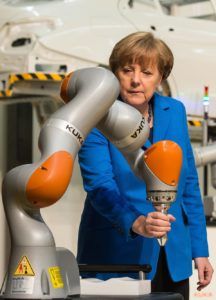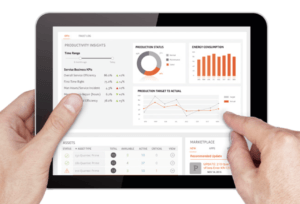Industry 4.0 – Keeping up with technology at KUKA

Staying at the technological forefront – how a 120-year-old German company adopted digital technologies to remain the market leader in industrial manufacturing equipment.
Headquartered in a town of 200,000 in Bavaria, Germany you will find KUKA, a leading manufacturer of industrial robots. The company has a long history dating back to 1898 and has managed to survive several technological step-changes during that time. During the 2nd industrial revolution which used specialized labor and electricity to enable mass production, the company became a leading supplier of assembly line welding equipment to Europe’s metalworking trade. During the 3rd industrial revolution which used electronics and information technology to automate production, the company became a pioneer for automated, programmable and articulated robot arms. Now that we are in the early stages of what many call the 4th industrial revolution or “Industry 4.0”, KUKA seems to be again on the cutting edge of technology.
Industry 4.0 and KUKA’s product offering
Industry 4.0 is the incorporation of the Internet of Things (“IoT”) into a factory setting. This makes for an entirely new production system which is characterized by an interconnected network of industrial robots and intelligent cloud computing systems. In these smart factories, cyber-physical systems monitor the physical production processes and make decentralized decisions based on large amounts of data collected by sensors on the manufacturing equipment[1].
KUKA, one of the leading companies providing Industry 4.0 systems solutions, is capitalizing on two key trends around digital technology in industrial applications and has adjusted its product offering accordingly.
I. Consolidation and enhanced management of horizontal and vertical value chains
Individualization is a megatrend shaping present-day societies all around the world. Thus, whereas until now the primary focus was on mass production at the lowest possible unit costs, the industrial production of the future will be characterized by high-quality, highly customized products[2]. Because the need for customization in their production processes increases complexity, this has become a crucial challenge for many manufacturers today. KUKA offers highly customizable, autonomous robots (see exhibit 1) necessary to perform this type of flexible production, modular software architectures that work with a client’s existing production IT systems and integrated cloudIT solutions that enable process improvement and machine learning. The underlying paradigm shift is that people will have real-time, detailed knowledge of the status across the entire value chain (from order to fulfillment) so that production can be agile and reactive. These integrated value chains are more timely, cost-effective and environmentally friendly.[3]
Exhibit 1
II. Highly customized digital products and services offering clients measurable value-add
Using customer-specific as well as big data analysis, KUKA provides its customers with additional services such as insight into further production process optimization potential, providing faster and cheaper machine maintenance, remote management of operating technology, as well as real-time energy optimization. These value-added features are delivered to the customer through KUKA’s award winning human machine interfaces (see exhibit 2).
Exhibit 2
Barriers to implementation and how KUKA can overcome them
There are some significant barriers to implementation for industry 4.0. The three most critical ones are:
- Networks: wireless applications today are not widely used in mission-critical applications, because they are not reliable enough. On the other hand, wired networks are costly to install.
- Security: Industry 4.0 requires the dissemination of large amounts of data between various value chain participants. Manufacturers often fear for their proprietary manufacturing knowledge in case this data gets leaked.
- Culture: as often has been the case in the past, seismic shifts in production technologies aimed at increasing productivity have people fearing for their jobs[4].
KUKA is working on solutions to overcome these issues:
- Cobots: KUKA has shifted away from the vision of a fully autonomous manufacturing plant and instead sees the future as one where robots and people collaborate. For this purpose, the company as developed so called Cobots, mobile Industry 4.0 robots that can collaborate and learn from their human counterparts. For example, Cobots can be used to assemble high-precision components with a tolerance spectrum not feasible for humans to achieve.
- Fog-networks: KUKA has started to create localized system-layers for the communication between operating technologies (so called Fog-networks). Collected data is then consolidated and transmitted to cloudIT systems through standardized and secured data formats, disguising proprietary manufacturing IP.
It is important to understand that the real value of this new production system lies in the scale of its integration. Because this idea is still relatively new, we are far from the adoption rate necessary to extract all the benefits this technology will provide, however, firms such as KUKA will help to speed-up the roll-out.
(Word Count: 735)
Sources:
[1] “What Everyone Must Know About Industry 4.0,” Forbes (June 2016), accessed 15 November 2016, http://www.forbes.com/sites/bernardmarr/2016/06/20/what-everyone-must-know-about-industry-4-0/#409f7a5c4e3b.
[2] “Hello Industrie 4.0 we go digital,” KUKA (April 2016), accessed 15 November 2016, https://www.kuka.com/-/media/kuka-corporate/…/press/broschuereindustrie40en.pdf.
[3] “Industry 4.0 – Opportunities and challenges of the industrial internet,” Strategy&, accessed 15 November 2016, http://www.strategyand.pwc.com/media/file/Industry-4-0.pdf.
[4] “The promise and the risks of IoT and Industry 4.0,” Plant Engineering (May 2015), accessed November 15th. http://www.plantengineering.com/single-article/the-promise-and-the-risks-of-iiot-and-industry-40/0e19866cc3ffa06bb320f064fcc9d646.html.





Great post Johann. I really like the benefits Kuka brings to supply chains and product development with Industry 4.0 and I believe it is very hard to argue that it is not a win-win situation for all or most players in supply chains. But, as we have seen in class, it seems like the implementation is the hard part in the development and adoption of innovative products such as Industry 4.0. Even pure-play ERP system companies face issues with integrating all players in a supply chain, I can envision that a robot manufacturer, which seems to depend heavily on its own physical products to be integrated within the Industry 4.0 concept, can face issues implementing it on a larger scale. Supply chain management unarguably increases efficiency and benefits do increase significantly with adoption on a larger scale, I simply think that adoption and implementation can be harder to scale if the provider manufactures robots and builds its supply chain management around selling other manufacturing equipment.
I think it’s very interesting and wise that Kuka is also pursuing cobots to address the issue of human displacement by automation. In this article(http://spectrum.ieee.org/automaton/robotics/industrial-robots/collaborative-robots-innovation-growth-driver), they claim that currently cobots only make up 5% of the total robot workforce, but that at BMW(another German engineering giant), they were able to reduce worker idle times by 85% through the use of cobots. I’m curious as technology advances if cobots could be a viable solution to worker displacement.